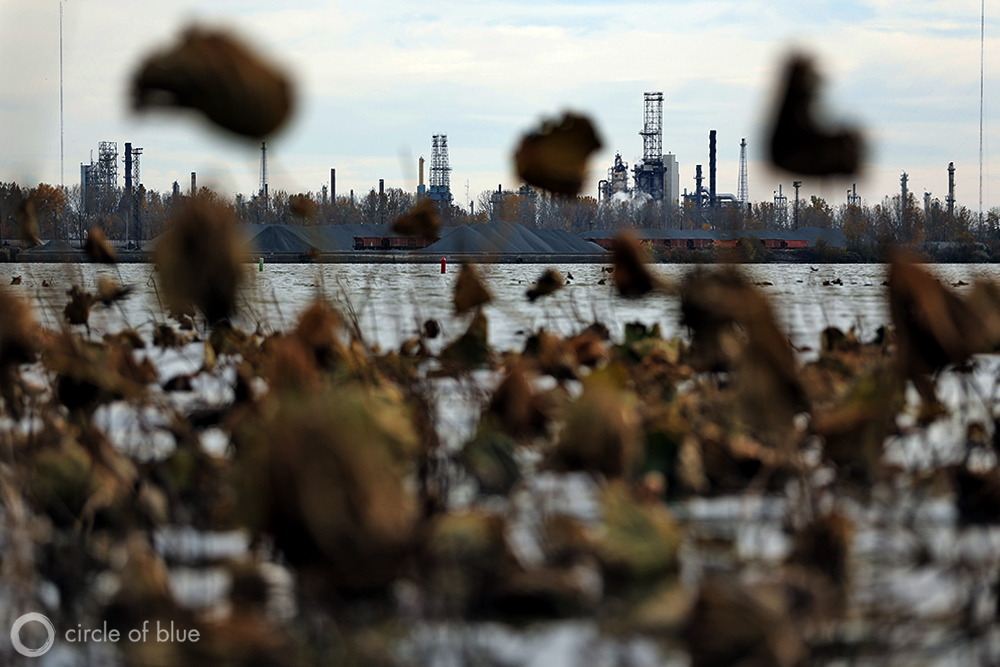Ohio Lawmakers Discuss Ways to Stop Lake Erie’s Toxic Algal Blooms
Explore options from stricter fertilizer regulations to funding water plant improvements.

Ohio state lawmakers met near Toledo today to hear from the public and begin laying out plans to stop toxic algal blooms in Lake Erie after a bloom earlier this month left more than 400,000 people in the Toledo area without safe drinking water.
Proposals for action announced in the wake of the public health crisis are focused on reining in nutrient pollution from Ohio’s agricultural industry, as well as providing more resources to help cities identify and respond to toxic outbreaks. Ohio, along with the other Great Lakes states and Canada, has pursued extensive studies of the harmful algal blooms, which have grown to record sizes in the past decade. Nonetheless, the issue has lacked political urgency until now—an election year for the state’s governor, 17 state senators, and all of the state house representatives.
Steps the state has taken as recently as June to improve fertilizer management are not sufficient, according to representatives from Lake Erie districts, who are also calling on the federal government to do more. Federal involvement has so far steered away from regulation, instead funding Great Lakes research and restoration projects through the Great Lakes Restoration Initiative, funding conservation programs through the Farm Bill, and funding national algal bloom research.
In Ohio, state representative Teresa Fedor (D-Toledo) says there are actions that can be taken now, without any new legislation, to protect Lake Erie and those who depend on it for drinking water. She and three other state representatives from Lake Erie communities have called on Ohio Governor John Kasich to declare the Maumee River a distressed watershed, declare Lake Erie an impaired waterway, and convene a meeting of Great Lakes governors to make commitments to reduce agricultural runoff. These actions would allow state agencies to more closely regulate fertilizer applications and the amount of phosphorus—the primary driver of algal blooms—that can be released into Lake Erie and its tributaries, Fedor said. Similar actions have already been pursued in Ohio’s Grand Lake St. Mary’s, near Columbus, and Wisconsin’s Green Bay watershed.
“We can’t do anything about phosphorus once it reaches the waterways, but we can do a whole lot about phosphorus on land and how it is managed” Fedor told Circle of Blue. “This is just a commonsense step towards protecting our waterways and protecting our drinking water, number one. It’s so solvable. It’ a no-brainer.”
In addition, Representative Michael Sheehy (D-Oregon) said he will introduce a bill to prohibit the spreading of manure on frozen ground. A provision regulating manure was left out of Ohio’s Senate Bill 150, a law signed by Governor Kasich in June that will require farmers to complete a state certification program for proper fertilizer application. Manure was not considered a fertilizer under the law.
“This bill is a common-sense first step towards curbing the amount of harmful chemicals that run into Lake Erie” Sheehy said in a statement earlier this week. “Manure application on wet or frozen ground is a major contributor to lake pollution and algal blooms, and experts have repeatedly pointed to these measures as good policy.”
Any bills dealing with fertilizer and manure applications will need to pass through the Agriculture and Natural Resources Committee of the Ohio House of Representatives. As part of Ohio’s mid-biennium budge review, the committee is currently reviewing House Bill 490, which deals with state agriculture, environmental protection, and natural resources programs. This bill could provide lawmakers with an avenue to enact changes to regulatory programs under agencies such as the Ohio EPA and Ohio Department of Natural Resources, according to committee chairman David Hall (R-Millersburg). Hall was recently tasked by the state Speaker of the House to study Lake Erie’s algal blooms.
“As we move forward looking at the algae blooms, we will probably see some other bills produced,” Hall told Circle of Blue. “I expect everything that deals with manure management, and anything else on that level, to go through my committee.”
Hall said he is looking at proposing stand-alone legislation to encourage conservation programs that reduce nonpoint runoff, but that Ohio and other Great Lakes states also need to look hard at improving water and wastewater treatment facilities and technology, as well as bloom forecasting.
“Using our satellite technology, we should be able to address when the blooms pop up, where they are at, and where they are heading,” Hall said. “Then we can warn our communities, just like we do with thunderstorms, that the water treatment plants should be prepared to treat the water at a different level.”
Representative Michael Ashford (D-Toledo) is considering legislation to standardize testing protocols for microcystin—the algal toxin found in Toledo’s water supply. The Ohio Environmental Protection Agency released suggested protocols Thursday, though they do not have the force of law.
“I am pleased that my proposal to test microcystin levels in our public water supplies is being taken seriously, and that the Ohio EPA is moving ahead with suggestions for testing,” Ashford said in a statement to Circle of Blue. “But to ensure the safety of Ohioans for generations to come, we need to preserve these suggestions as requirements in Ohio law with a dedicated funding stream attached. In the coming weeks, I’ll see if it makes sense to introduce a bill to do just that.”
Governor Kasich’s administration announced Thursday that it will make $US 150 million available in no-interest loans for communities to improve their drinking water and wastewater treatment facilities, as well as $US 1.25 million for farmers to implement best management practices to reduce nutrient runoff, and $US 2 million for Ohio universities to pursue research on algal blooms. Additional federal funding may also become available through the Farm Bill’s $US 1.2 billion Regional Conservation Partnership Program. States across the country can compete for the funds to complete conservation goals, and a joint application from Ohio, Michigan and Indiana is currently pending approval.
“The federal government has to make this a priority,” Representative Fedor told Circle of Blue. “If they could just imagine themselves waking up like I did and being told they can’t touch the water—the can’t drink it, they can’t boil it, they can’t give it to any animals—just imagine how different their lives would be, because I can tell you that life will never be the same in Toledo after this experience. This is not just a Toledo problem, this is a national problem and an international problem. It is a problem that has ready solutions if there is the political will to do so.”
A news correspondent for Circle of Blue based out of Hawaii. She writes The Stream, Circle of Blue’s daily digest of international water news trends. Her interests include food security, ecology and the Great Lakes.
Contact Codi Kozacek











Leave a Reply
Want to join the discussion?Feel free to contribute!